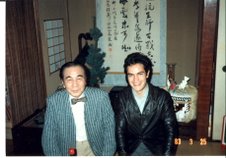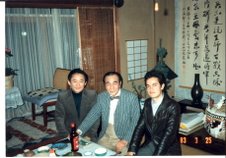Yungueñita
Yungueñita,
on the other hand, is a straight arrangement. "Straight" in the sense
of not having as its primary objective to establish a dialogue between two
musical languages, as is the case with the Beethovenianas bolivianas. In
a wider sense, however, every arrangement is a dialogue between the arranger,
his time and his cultural context, and the composer of the original - whether
known or anonymous - his time and his context.
My
own understanding of arranging was transformed radically when I discovered the
work of Percy Grainger. I did so somewhat belatedly. About twenty years ago (I
write this in 2019) my friend, the magnificent all-round musician Alan Fearon,
played me a recording of Shallow Brown. We were in his sitting room in Jesmond Vale, overlooking the Dene, and
I remember being struck by the sea-like texture provided by the guitar
tremolos and by the epic, affirmative responses from the male choir. I knew too
little about the context of the sea shanty and the context of Grainger to give it
much more thought than that.
About
a decade later, my companion in life experienced something of a
Grainger epiphany. Of course she knew her Grainger already, but something must
have happened to bring it back to her attention. I remember her exhilaration
when she came back to the house having listened to Shepherd’s Hey in her car. She played it again for me and I was thrilled; it was the orchestral
version, conducted by Leopold Stokowski. That launched a period of listening, reading
and talking Percy Grainger. Before long my composition students had to engage
with some Grainger too. Said companion went on to curate a very successful Prom
concert showing the connection between Grainger and specific tunes from the
English repertoire.
Having
immersed yourself in Grainger, arranging could never again be the workaday task
you once did semi-reluctantly, usually on request and as a compromise between your
keenness to have work performed and the performer’s half-hearted commitment to engage with your work – keen enough to play something yours, but not so keen as to
play one of your "proper" pieces.
Grainger
elevated for me the task of arranging a folk tune to a level of the highest order
of creative challenge. Any arrangement to be undertaken from then on would have
to engage not only with the melodic and rhythmic contents, but with the
performance practice of the tune’s time and place, and with its cultural
context. And it would have to do so from a position of respect, affection and
as much knowledge as possible. Daunting.
I
met these challenges headlong in the next arrangements I wrote after that. The
first was Collier’s Rant which began for six choirs and then had to be
shrunk for four. A quick scan through this blog reveals I did not write about
it at the time; that has to be remedied and I should do it soon.
The
next was not one, but a series of arrangements for string orchestra commissioned
by Bolivia Clásica, which I refer to as Arreglos bolivianos. Two of them,
Collita and Viva mi patria, are being performed and reproduced
with touching frequency in Bolivia, for example by the television channel ATB during
a ten-day period leading up to the 194th Independence Day this year.
I may come back to that project in this blog if I have time.
Today’s post is about Yungueñita, a taquirari – another taquirari, if you remember that the piece in the last post, Beethovenianas bolivianas No. 1, is also one. Taquirari is probably the first music I knew, or at least the first music I remember hearing back in my childhood in Montero. My current obsession with the genre may have something of a closing of a loop.
This
arrangement, which I finished a few days ago, is for Trío Apolo, Bolivian
friends, based in my native town. They are the ones who commissioned my Trio back
in 2004. They are currently embarked on an ambitious programme of outreach work
and, as part of that, they have asked me to write a number of arrangements. I
understand that they were motivated to approach me about this after hearing Arreglos
bolivianos when Bolivia Clásica did their patriotic project with Jaime Laredo
in 2014.
It was perhaps wayward of me to give them Beethovenianas bolivianas No. 1 as my first instalment, since, as I hope to have explained in the last post, that is not an arrangement of any known folk tune. Yungueñita is closer to the brief.
Yungueñita closes a loop in more than one sense – not only by virtue of being a taquirari. This arrangement is, in fact, informed by another arrangement, one I wrote around 1978 for Orquesta de Cámara Municipal. I was a member of it at the time, leading the viola section, and I was very much in the position I alluded to above, desperate to have my work performed but finding that the management, although well disposed, was not willing to risk a contemporary work. They suggested a folk arrangement instead, and I gave them Yungueñita.
The title means "female from Yungas". Strictly speaking that would be yungueña, but there is a very Bolivian diminutive ending which makes the word more personal, more affectionate. Yungas is a semi-tropical region near La Paz, and this song is something of a classic of La Paz folk music. Taquirari, quintessential to the eastern lowlands, is by no means a La Paz genre – even though, strangely, another La Paz classic which I have also arranged, Collita, is a taquirari too. Collita’s lyrics make it clear that the song is a homage to a woman of La Paz by a man from the east of the country. There is no such explanation for Yungueñita. All the lyrics do is reproach her for a change in her loyalties, mentioning in passing that the man singing is black.
I was blissfully ignorant of Yungueñita's authorship in 1978 and, to my shame, the first few performances had the composer’s credit as Anonymous in the programme. It was after one of the concerts of Orquesta de Cámara Municipal that the manager, Juan Antonio Maldonado, came to tell me that a composer had materialised, that his name was Víctor Hugo Serrano and that he was indignant that he was not being credited – but that he was delighted with the arrangement. It was all settled in a friendly manner.
I was blissfully ignorant of Yungueñita's authorship in 1978 and, to my shame, the first few performances had the composer’s credit as Anonymous in the programme. It was after one of the concerts of Orquesta de Cámara Municipal that the manager, Juan Antonio Maldonado, came to tell me that a composer had materialised, that his name was Víctor Hugo Serrano and that he was indignant that he was not being credited – but that he was delighted with the arrangement. It was all settled in a friendly manner.
I do not have access to the score of the 1978 arrangement, but, although forty-one years have elapsed, we played it so often around that time that I remember it reasonably well. The new arrangement for Trío Apolo retrieves the melody of the introduction (not part of Serrano’s tune) and a couple of countermelodies. The rest is new.
Something that was distinctly lacking in the older arrangement was any serious attempt to engage with the rhythmic subtleties of taquirari. I did some detailed exploration on this for Collita and for Pensando en ti (both are in Arreglos bolivianos of 2014). I take the search one step further in Beethovenianas bolivianas No. 1 and, I think, another step in Yungueñita.
Computer simulation!
-->




No comments:
Post a Comment